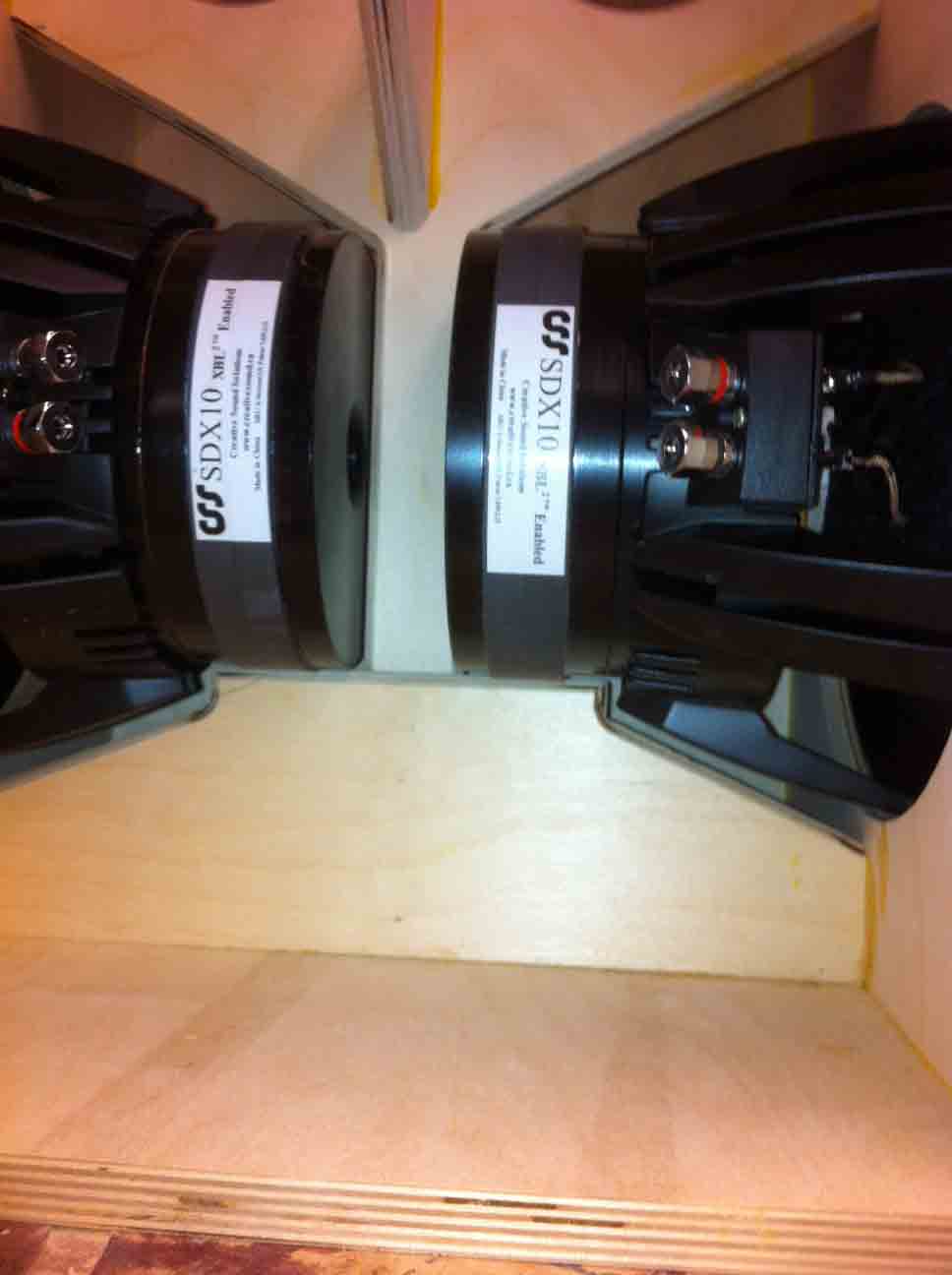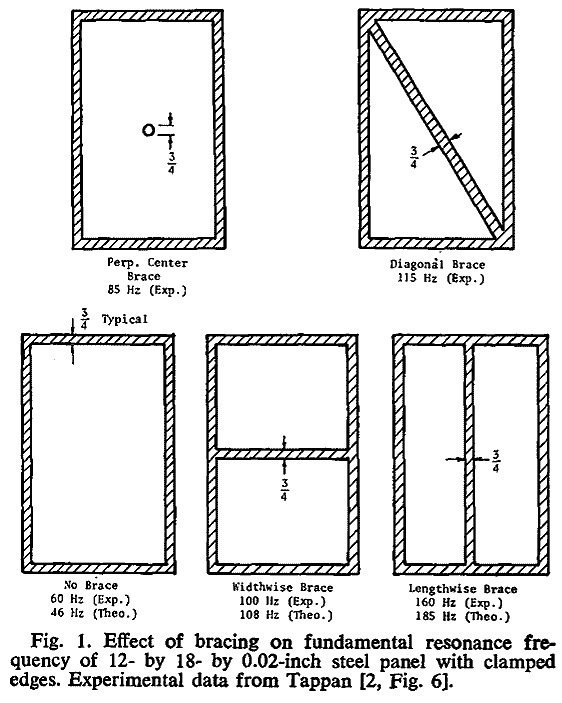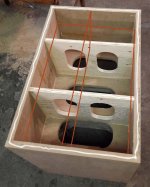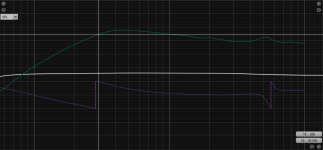At what point does a windowpane brace become too restrictive, cause resonant cavities, etc... The best I can reason is that is the brace is looked at as a port to the cavities it separates, as long as the "tuned" frequency of those windows (ports) and cavities are well outside the design Fs all would be well.
This question came to mind as i was looking through some pictures and came across my sealed UM-18 box. I will be opening up soon to add some stuffing so I could cut out some voids while I'm in there. Necessary?


This question came to mind as i was looking through some pictures and came across my sealed UM-18 box. I will be opening up soon to add some stuffing so I could cut out some voids while I'm in there. Necessary?
The braces in that box would be much more effective if rotated 90° to follow the guideline: The subpanel created by a brace should have a higher aspect ratio than teh peanl which it is bracing. The sub panel aspect ratios should be different.
As long as the holes are large enuff — yours perhaps a bit skimpy — will not affect a selaed or bented box, they can screw up a TL.
MDF outside braces are plywood?
dave
As long as the holes are large enuff — yours perhaps a bit skimpy — will not affect a selaed or bented box, they can screw up a TL.
MDF outside braces are plywood?
dave
Maybe I am not picturing the aspect rule properly. The enclosure is almost a square on the side so the aspect wouldnt change much. The pics dont give a good perspective.
Its 1"MDF and yes, the two braces on the speaker side are 3/4" plywood. The design was that much more than 1 sheet of MDF. The outside is laminated on pre finished 1/4" plywood.
Its 1"MDF and yes, the two braces on the speaker side are 3/4" plywood. The design was that much more than 1 sheet of MDF. The outside is laminated on pre finished 1/4" plywood.
Interlocking bracing panels connecting each pair of opposing panels certainly delivered efficacious results in the push-push SDX10 enclosure, in which IIRC, the drivers weighed more than the BB plywood cabinet. No doubt Dave can find photos of that and many other implementations of the strategy
Scrap 15mm BB. A build to show the effectiveness of push-push loading in a woofer.
Only picture i have handy. This woofer is also a prism with a close to square base. But unlike yours, braces go the preferred way and the drivers have active reaction force cancelation dramatically decreasing the vibrational load on the box.

dave
Only picture i have handy. This woofer is also a prism with a close to square base. But unlike yours, braces go the preferred way and the drivers have active reaction force cancelation dramatically decreasing the vibrational load on the box.

dave
@planet10 I see what you mean. The box is ~30x30x20 for ref. It measures like the tuning was not affected by it.
Measurements suggest that the skimpy windowing did not affect anything.

However there is a serious ring at around 200Hz. Not audible above pink noise but precarious. Tap test suggests its the cone. Im hoping my endeavor of adding some stuffing will help damp this out.

Measurements suggest that the skimpy windowing did not affect anything.
However there is a serious ring at around 200Hz. Not audible above pink noise but precarious. Tap test suggests its the cone. Im hoping my endeavor of adding some stuffing will help damp this out.
Attachments
Garboi: note in the photo above that the motors‘ rear magnet slugs are nested snugly to the cross brace - something that even with deadly accurate CNC machining can require some fiddle-futzing, particularly in the case of trapezoidal shaped enclosures. On more than one occasion that was achieved by inserting slips of iron-on veneer edgebanding.
Last edited by a moderator:
In theory such box size/shapes are presumed to have a ~uniform particle density and only load up to the driver's upper mass corner (Fhm) where T/S theory peters out, so strong box modes never come into play.
Fhm = 2*Fs/Qts'
(Qts'): (Qts) + any added series resistance (Rs): http://www.mh-audio.nl/Calculators/newqts.html
Fhm = 2*Fs/Qts'
(Qts'): (Qts) + any added series resistance (Rs): http://www.mh-audio.nl/Calculators/newqts.html
Seems reasonable considering its very low Fhm.@planet10 I see what you mean. The box is ~30x30x20 for ref. It measures like the tuning was not affected by it.
Tap test suggests its the cone.
This is the diagram pulled from the AES paper that leads to the guidline i posted early on.

dave

dave
I recall somebody in this forum section saying many years ago that any bracing that took up more than 10% of the boxes volume was too much.
Combined with Daves recommendations about random/ not quite even spacing that sounds 'bout right to me
Combined with Daves recommendations about random/ not quite even spacing that sounds 'bout right to me
And the thing missing from this sophisticated discussion is knowing how much cab noise (internal and wall vibration) it takes to perceptibly deteriorate listeners' enjoyment. Or even be detectable with music playing in background. Or even be detectable without music playing in background.
BTW, the big cab vibrations occur during loud music passages, eh.
Having made a very satisfactory 17-foot labyrinth from quarter-inch plywood (with some bracing), can't say as I fret over the unverified fear of cab noise (and it measures well).
I admit I've been knuckle-rapping on cabinets for 65 years - can't break the habit.
B.
BTW, the big cab vibrations occur during loud music passages, eh.
Having made a very satisfactory 17-foot labyrinth from quarter-inch plywood (with some bracing), can't say as I fret over the unverified fear of cab noise (and it measures well).
I admit I've been knuckle-rapping on cabinets for 65 years - can't break the habit.
B.
Quick question on braces: How much of a role do the shape's of the windows play?
A lot of medium sized circles, or a few big reactangles? Or rectangles with rounded edges, like @garboui did?
I know circles have better "flow rate" of liquids and the highest speed will be at the center, which is more critical for bass reflex vents.
But inside the box will be more than enough "vents" to let air fluctuate back and forth, even if they're reactangular, I imagine.
A lot of medium sized circles, or a few big reactangles? Or rectangles with rounded edges, like @garboui did?
I know circles have better "flow rate" of liquids and the highest speed will be at the center, which is more critical for bass reflex vents.
But inside the box will be more than enough "vents" to let air fluctuate back and forth, even if they're reactangular, I imagine.
- Home
- Loudspeakers
- Subwoofers
- How much windowpane brace is too much?

